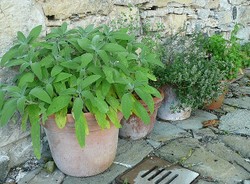Botany throws up new discoveries on a regular basis. New species and varieties are often found, but more rarely does a supposedly lost species present itself to us. Finding such a species is hard work, for most plants that you find are common types. Botanical explorers need stamina, persistence, keen eyes and a detailed knowldge of plants. Occasionally they strike lucky. This is about one whose lucky day came.

Silphium Rediscovered
by frankbeswick
A highly prized culinary herb has almost certainly been discovered, even though it was thought extinct for nigh on two thousand years.
A Stroke of Luck
When starting a career in science young people dream of the day when they make the great discovery, revolutionising thought, finding a cure for a serious disease, and so on. But most discoveries are small, though they give satisfaction to the finder. However, occasionally a discovery gets into the news, and it might cross the boundaries of different academic subjects. The rediscovery of the herb known as Silphium to the Romans and Silphion to the Greeks has medical, scientific and historical value.It was found in an area where no one had ever searched for it, which makes us realize that too often we are looking in the wrong place.
Mahmut Miski, professor of Pharmacognosy, the study of medicines derived from plants, needed to be fit enough to hike across the mountainous lands of Turkey. But he made the first steps in what was to be a long project in 2012 when he was a young post-doctoral researcher, trekking the highlands of Cappadocia in search of yet unknown medicinal plants. It was 2021 when he published his researches, by which time he had become a professor. On speaking to Turkish shepherds and goat herds he was told of a plant whose description he did not recognize, but when they said that eating it made goats sneeze and sheep go to sleep he knew that the plant had pharmacological significance. So he took a look and what he saw made him suspect that he was onto something significant.
Clearly the plant was a member of the Apiacaea, the family to which carrots and parsnips belong. It is a plant family that contains not only edibles, but some herbs and also a number of posionous plants, quite deadly ones.But this one had leaves that seemed to appeal to animals, and the shepherds identified it. It belonged to the genus Ferula. But Mishi's mind made a connection that jumped across academic boundaries.He had seen Roman coins with engraved images of a much desired medicinal and culinary herb, Silphium, thought to have become extinct in the first century CE.This plant resembled those pictures. What is more ancient accounts of Silphium fitted the description of what he had found: a yellow flower and large, fleshy roots.Soon his research into ancient documents revealed that its medicinal use in our time in folk medicine was similar to the medicinal use of Silphium. The clinch came when research showed that the plant would spring up after a fierce downpour known as Black Rain, when it could sprout to six feet tall in a few weeks. The scientists' dream had come true. He had redicovered the lost herb, Silphium. But this was to be the beginning of a long process of work in the laboratory and the greenhouse, a work that is still in process.
A Roman Delicacy
The final mention of silphium in classical literature comes in the works of Pliny the Elder, who collected a single specimen of this delicacy to present to his emperor Nero. When Nero is your boss it pays to grovel a bit. The specimen had been collected in Cyrenaica in North Africa and was the last specimen of the plant that could be found in this area where it had once been abundant. The specimen was added to the imperial stores, which kept a stock of Silphium, which was valued on a par with silver. We presume that Nero ate it. The plant was used as a flavourant and was liberally added to Roman feasts. It was cooked in various ways: boiled, fried or sauteed, and was considered a vital ingredient of upper class banquets. It was also used in Roman herbalism, where it had a variety of uses, one of which was as a contraceptive. How well it worked I know not, but it would not be the only member of the Apiacaea to serve this function.
The trouble with Silphium was that it stubbornly resisted cultivation.The Romans tried to transplant it from its home in Cyrenaica, but to no avail.There were attempts to collect seeds and grow from them, but they did not work. No one in the ancient world knew why, but the failure might have been connected with its need for a downpour. The North African chiefs were reduced to collecting it through the agency of desert nomads, who did a good trade by collecting and selling specimens to the rich urban society. So when the wild trade went, so did Silphium.
So how did it get to Cappadocia? Trade around the Mediterranean was prolific, so it was likely that someone at an unspecified time had brought seeds from Africa and planted them in Cappadocia, and these seeds grew. There were Greek cities in North Africa, Cyrene, in Cyrenaica, for example, the home of Simon of Cyrene, who is mentioned in the story of Jesus' crucifixion. There were Greeks right across modern Turkey, which was known as Asia Minor.Perhaps the propensity of mountainous regions to heavy rainfall created the conditions that Silphium needed to flourish, and maybe the fact that the Cappadocians were unwilling to broadcast to the world that they had silphium growing in their territory led to its preservation.The only way to preserve it for themselves was to keep the herb a secret.
Silphium Now.
Some progress has been made in propagating the herb using modern methods. The plants were successfully propagated in glasshouses [greenhouses.] though the collection of the seeds took some time and there were times when the propagation failed. Mishi required the services of expert horticulturalists to aid him in his endeavours. Controlled applications of water enabled the necessary amounts of irrigation, so the cultivation is making progress, though it is still on a non-commercial scale.But it has been nine years, and in the meantime its young discoverer has become a professor.
Integral to the research has been an investigation into the plant's use in folk medicine. Folk medicine, which is very much based on herbs, is a useful guide to a plant's uses, but it is not infallible, and it benefits from the great strengths of modern scientific research, which can unravel the mysteries of a new plant's genetics and perform biological analyses of the plant's biochemistry. So far scientific study at Istanbul University has revealed that there are at least thirty chemicals that would repay further study for their medical properties. Folk medicine uses Silphium as a remedy for warts, among many other uses, but scientists are confident that some of the chemicals discovered may aid in the fight against cancer. We will have to wait and see. But the study will take some time, as each chemical will require detailed scientific study, a task made all the more complicated by reseachers having to study the interaction of the various chemicals.Science is a joyful enterprise, but success follows lots of routine hard work.
But there is also the need to get the plant into cultivation on a commercial scale, and this step must wait for the ascertaining of the uses of silphium's stock of chemicals.At this stage business steps in.Could amateur growers produce specimens in their own plots. Time will tell, but Silphium does not seem easy to grow.
The final stage will come from the chefs. Silphium was a delicacy in the ancient world, and there is nothing to prevent it from being so again. Such a delicacy should be available to all, not just to the Nero's of this world.
I am an Amazon associate and earn money from qualifying purchases on this page.
You might also like
Cassie Liversidge’s Homegrown Tea Planting, Harvesting, Blendi...Cassie Liversidge’s Homegrown Tea offers an illustrated guide to planting, ha...
Five Useful Herbs for Your GardenThinking of starting a herb garden? Choose these five useful herbs to get goi...
After the Boston Tea Party: Herbal Liberty Teas Suggested by P...The Boston Tea Party ushered in a period of herbal tea drinking in Colonial A...









 TheThousand Year Gardenon 11/26/2025
TheThousand Year Gardenon 11/26/2025
 Women of the Gospelson 10/11/2025
Women of the Gospelson 10/11/2025
 Religious Gardenson 08/25/2025
Religious Gardenson 08/25/2025
 Doctor of the Church: John Henry Newmanon 08/03/2025
Doctor of the Church: John Henry Newmanon 08/03/2025




Comments
Some grains require hot climates, e.g. millet and to a lesser degree maize, but barley tolerates cooler conditions, whereas rye can cope with more difficult soils and climates.
Thank you for your comment below, in answer to my previous observation and question.
Wheat adaptability intrigues me.
Is it the only adaptable grain or is such adaptability all part of -- ;-D -- being a grain?
Mediterranean plants are suitable for low fertility soils. Some plants are adaptable, such as wheat, which grows well in the Mediteranean region.
Thank you for all your comments, in answer to my (and others' ;-D) previous observations and questions.
May we go 18 comment boxes down, to the date Oct. 2, 2022?
Your answer mentions that "As for soil,as it is in the Apiaceae it copes with less fertile soil.So desert and mountain soils might suit it better than very fertile soils, but there are parts of Europe where t.he soil might be suitable."
All the mosquitoes now needle me about how treatments nurture adaptable, immune, strong successors.
And yet silphium plants prefer less fertile soils.
Over time would quartering them in "very fertile" soils result in their termination or would adaptability reward them with range changes, from "less fertile" no more to "very fertile" from henceforth?
It is not, clear, so we must display cautious judgment.
It's possible that silphium comes from two words, sil for "yellow" and -ion for diminutiveness.
No internet sources list any language or word regarding the former even as English wiktionary mentions it as a yellowish pigment appreciated by ancient artists.
But English wiktionary mentions the writing stylus graphium as from the same-spelled Latin from the Ancient Greek γραφεῖον (= grapheîon), formed from γρᾰ́φω (= gráphō) for "to cut into/draw/paint/scratch/sketch/write") and the diminutive suffix ιον (+ ion).
Ergo, Latin ending -phium = Greek ending -ion = diminutive appearance of yellow-flowered silphium!
Would that sound etymologically possible to you?
I am afraid not.
Word origins interest me as perhaps you infer from my etymological questions to some wizzlies ;-D.
So I looked into silphium. Internet sources mentioned nothing even as I noted sil -- without any country or language association apart its entry under English -- as described as a yellowish pigment under the entry "sil" on Wiktionary.
Online sources offered nothing regarding -phium even as the Wikipedia article List of Greek and Latin roots in English/P puts "muzzle" as the English meaning of the prefix -phim!
Would you know of any explanations for why silphium came to be called silphium?
No, we have noted nothing unusual.
There's a saying among traditional Hawaiians that some animals and plants that may seem extinct may endure by having altered or expanded -- such as what it sounds like happened with silphium, but in the Hawaiian context by animals relocating or plant seeds wildlife- or wind-dispersing -- their original range.
That proved true, for instance, in summer 2010, when [volcano goddess] Pele's bellflower (Clermontia peleana) was discovered in Hawaii County's big-island forests on Kohala volcanic slopes. They never were there before.
Would there be some such discovery that you heard about or that you witnessed during your and your wife's many county, hill and mountain walks?